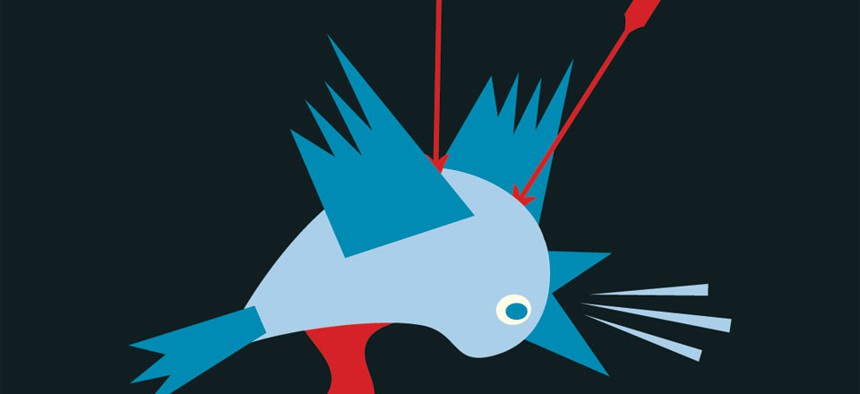The 9 Ways That Twitter Could Fail, According to Twitter

igor kisselev/Shutterstock.com
Befitting any young, undeveloped, and unprofitable company, the list of risks is long and wide-ranging.
Twitter has filed for an IPO. This document, called an S-1, is like a cover letter for a young firm trying to impress big institutional investors to buy the stock on Day One (and hold onto it). But in addition to the chest-pumping, every company is obligated to enumerate the risks that could destroy it.
Like the weaknesses part of a cover letter, the risk section is arguably the most interesting part of the S-1. It's where, for example, Facebook famously misled retail investors about its weakening desktop business, before the company had properly built out a mobile business.
Befitting any young, undeveloped, and unprofitable company, Twitter's list of risks is long and wide-ranging, from Maybe we'll stop adding users to Maybe China will ban us forever. Here are the most significant and fascinating risks the company fesses up to (for a full list, go to page 16 of the S-1).
(1) What if Twitter has simply stopped growing? There is some evidence of stagnation. Twitter announced 215 million monthly active users today, meaning "it's added only 15 million since it hit more than 200 million late last year," according to Mike Isaac. Twitter acknowledges that if users top tweeting (or if their tweets are bad and go unread), the company will slowly bleed advertising, as well.
As just one social media/news app in a crowded field, Twitter also acknowledges that its most serious competition has much, much more money, including Facebook (with Instagram), Google, LinkedIn, Microsoft and Yahoo!—and that's just in the U.S. "Facebook operates a social networking site with significantly more users than Twitter and has been introducing features similar to those of Twitter," the company admits.
(2) What if Twitter really never learns how to make serious money? Twitter generates nearly 90 percent of its revenue from advertising and more than half of its revenue from mobile advertising. It has three products -- Promoted Tweets, Promoted Accounts and Promoted Trends -- but none are quite proven. "If we are unable to demonstrate the value of our Promoted Products to advertisers and advertising agencies," Twitter says, it will suffer from both a stagnating user base and a stagnating monetization strategy.
Twitter is trying to introduce new features it can turn into money-gushers. Vine, the six-second video feature, offers another window to serve native ads. Amplify gives TV advertisers the ability to re-target viewers with Promoted Tweets. The company has also teamed with Nielsen to produce a TV rating system which, while generating no revenue today, suggests a future where Twitter sells its data. Still, these initiatives are too young to celebrate or lambast, just yet.
(3) What if Apple or Google design an operating system that ruins the Twitter experience? Twitter isn't vertically integrated. It works on other people's devices, browsers, and operating systems, like Mac OS, Windows, Android, iOS, Chrome and Firefox. "Any changes in such systems, devices or web browsers that degrade the functionality of our products and services or give preferential treatment to competitive products or services could adversely affect usage of our products and services," the company says.
(4) What if Twitter fails to expand internationally? Twitter needs more users. The trouble is that, in many populous and connected countries, it faces competition and other barriers. Twitter is blocked in China. Some countries have nearly identical or highly similar services, like Sina Weibo in China, LINE in Japan and Kakao in South Korea. In other markets, like Europe, government regulation restricts its freedom to advertise. In less developed countries, like India, poor Internet connections makes Twitter less viable. All this matters because the typical monthly unique overseas is worth 23 percent less than an American user.
(5) What if Twitter never manages to turn a profit, at all? "We may not be able to achieve or subsequently maintain profitability," Twitter acknowledges. Indeed, it's lost about $420 million in its lifespan. Although revenue has grown from practically nothing in 2009 to $317 million last year, the company expects that breakneck pace to slow as the user base slows.
(6) What if Twitter suffers the mother of all Fail Whales? Twitter is massive and mostly smooth even during peak hours. But it's still vulnerable to infrastructure breakdowns. In the company's own words:
We have experienced, and may in the future experience, service disruptions, outages and other performance problems due to a variety of factors, including infrastructure changes, human or software errors, hardware failure, capacity constraints due to an overwhelming number of people accessing our products and services simultaneously, computer viruses and denial of service or fraud or security attacks.
(7) What if foreign governments get in the way? Around the world, governments and regulators are proposing data-protection and privacy laws that could affect Twitter's business. "These laws and regulations are subject to change and uncertain interpretation," which could cost Twitter, not just future users, but also money paid out in penalties and lawsuits.
(8) What if hackers get in the way? Twitter experiences cyber-attacks "on a regular basis." In February 2013, hackers gained access to 250,000 accounts. "Any such breach or unauthorized access could result in significant legal and financial exposure, damage to our reputation and a loss of confidence in the security of our products and services that could have an adverse effect on our business and operating results," Twitter said.
(9) What if Twitter gets in its own way? Throughout its risk section, the company is candid about all the ways it could screw itself: management fails, a short-term focus that compromises long-term vision; a long-term focus on innovation that takes away from quarter-to-quarter revenue growth; or a breach or massive screw-up that loses the trust of marginal users and devastates growth.
(Image via igor kisselev/Shutterstock.com)
NEXT STORY: Amazon-IBM dispute enters next phase





